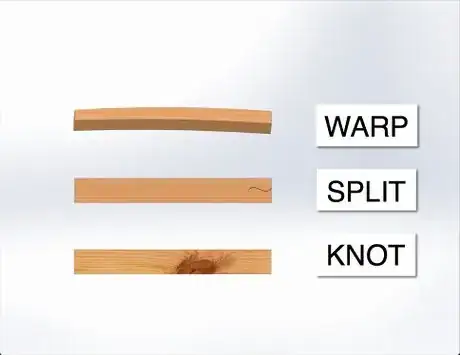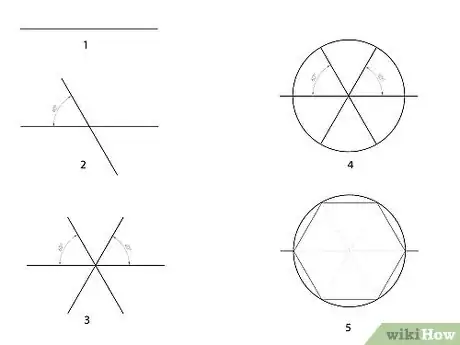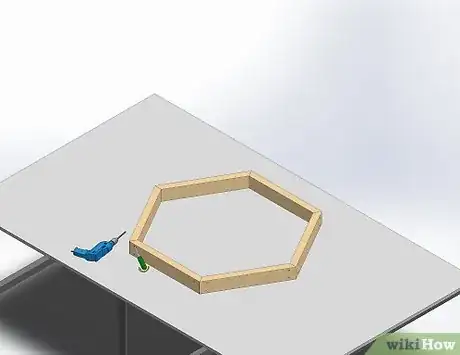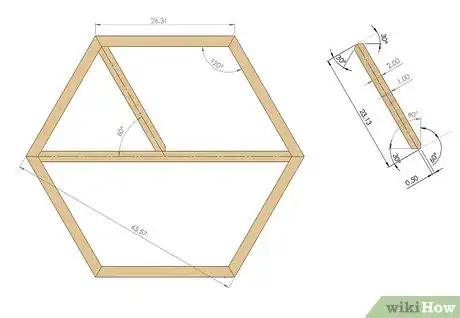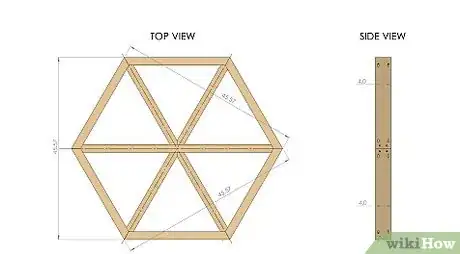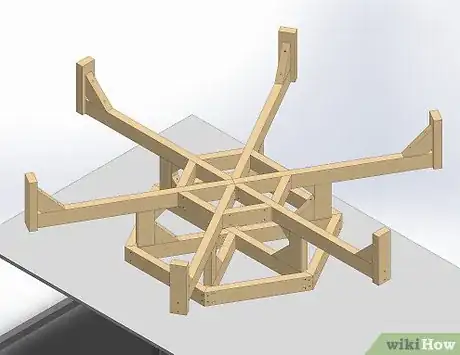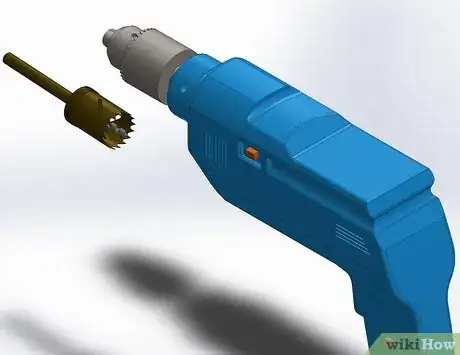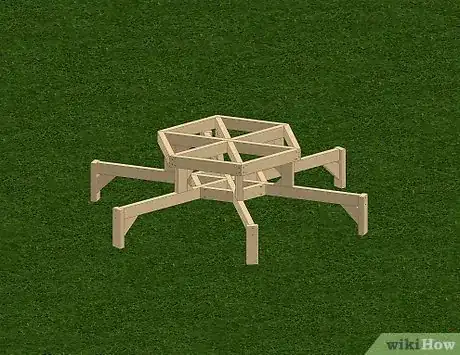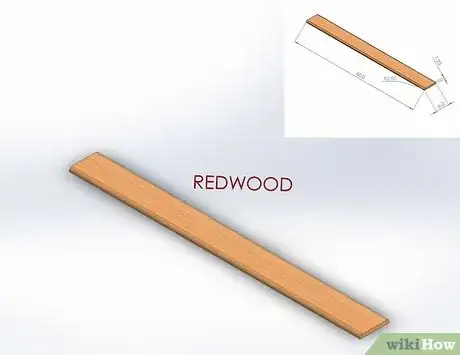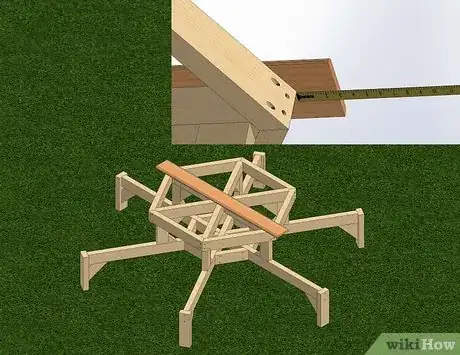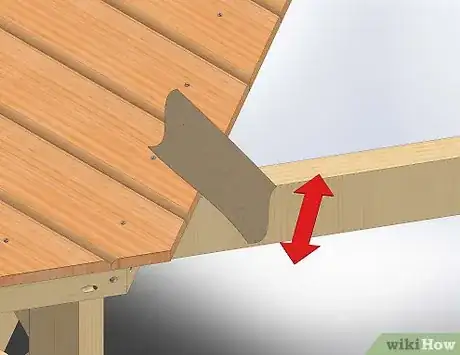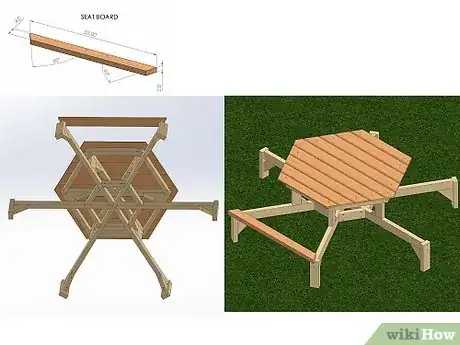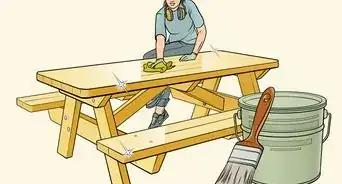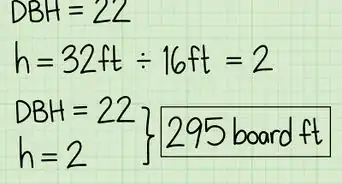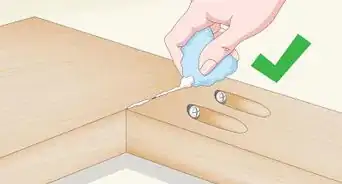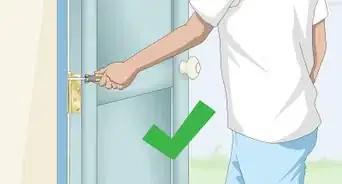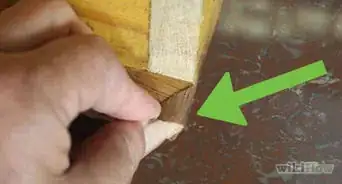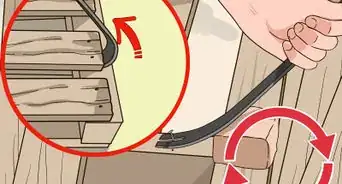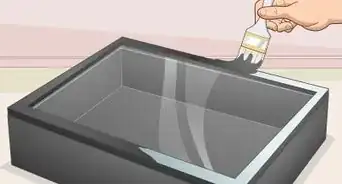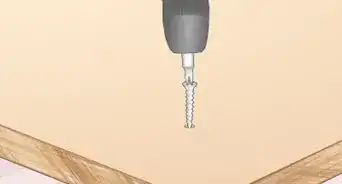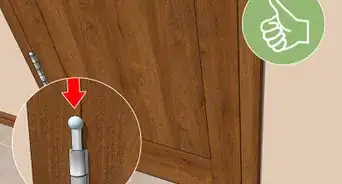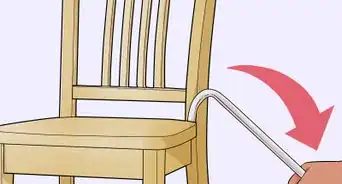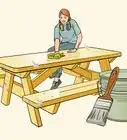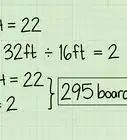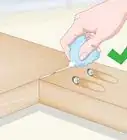wikiHow is a “wiki,” similar to Wikipedia, which means that many of our articles are co-written by multiple authors. To create this article, 12 people, some anonymous, worked to edit and improve it over time.
wikiHow marks an article as reader-approved once it receives enough positive feedback. In this case, 96% of readers who voted found the article helpful, earning it our reader-approved status.
This article has been viewed 163,607 times.
Learn more...
Picnic tables can be a great place for a family gathering or for outdoor art projects. This design is great for meals, since everyone is facing toward the center, and items on the table are in easy reach of all the seated guests.
Steps
-
1Gather the required materials (see, Things You'll Need, below). You want to buy good quality materials with minimal knots, splits, or warping. Cedar, redwood, or even the new recycled plastic decking is best for flat surfaces. In this article, treated southern, yellow pine lumber is used.
- Set up a work area so you can cut and assemble parts conveniently. You will need a workbench or table at least four feet square, as well as saw horses and a bench for your miter saw.
-
2Mark the basic hexagon shape of the hub, or center of your table on your work table or a sheet of plywood. This will help you place pieces in the correct position.
- You can lay out the hub with a framing square, drawing a center line, transversal (with its length roughly 1 1/2 inch (3.75cm) longer than 2 spokes placed end-to-end), then marking two 60 degree angles on each side at the center so the third angle between them on each side will be 60 degrees also (for 6 x 60 = 360 degrees), then measuring out from the center point equal distances (in the length of the spoke), and finally, connecting these points to form the outline of the hexagon (for 6 equal outer edge boards).
Advertisement -
3Use the drawing on the table surface to establish the length of the members that will form the "band" (outer edge boards) of the hexagon. For the table in the illustrations, the six sides are 24 inches (61cm); cut off a 30 degree angle from each end (leaving 60 degrees). Of course, when pairs of sides are put together while forming the band, the resulting table corner is 120 degrees.
-
4Fit the ends together to form a hexagon with equal sides, then fasten the ends with 2 1/2 inch (6.35cm) galvanized or corrosion resistant wood screws. Pre-drill the holes through one side of these corners so they grip tightly and don't split.
-
5Check to make sure each side is equal after the sides are fastened together by measuring across parallel sides. For the example project, each side is about 45 inches (114cm). A simple trick to keep the sides from slipping or moving, toenail two sides with wood screws to the table top until the spokes, or internal framing members are fastened.
-
6Cut a two by four to fit between two opposite corners, making a 30 degree cut, at each end, off the corner on each side to the center of the 2 inch (5cm) way. You might scribe these cuts, if you are unable to get an accurate measurement.
-
7Fasten this 2X4 (5cm X 10cm) at each end with wood screws. Again pre-drill the band so the wood doesn't split and the screws pull up tightly. This assembly will be the basic support for the tabletop, and fitting everything flush (straight and aligned) and tightly joined together will give you a good, solid finished table.
-
8Cut the four spokes. Measure the length of the spoke from the center of the transverse 2X4 inch (5cm X 10cm) out to one corner. Cut your spoke to that length.
To cut the angles on the spoke, first scribe the center of the 2 inch (5cm) way on each end. Then cut the outer pointed-end of each spoke by cutting off 30 degrees from each edge to your scribed center.
The hub-end will be cut 30 degrees to the center mark off one edge only, and 90 degrees off this end cut, from the center, to the other edge, thus dropping 60 degrees -- or after cutting 30 you could cut off 60 degrees to the center off the second edge, which would automatically leave that desired 90 (since 30+90+60 = 180). -
9Fasten these spokes in by screwing the first two on one side through the center board, and the opposite by toenailing with wood screws through the bevelled end. Again, pre-drill holes where possible, especially when fastening very near the end of the board.
-
10Check the finished frame to make sure it is symmetrical and all sides are equal. Check that the edges are flush on both the top and bottom. Be aware that even finished lumber may vary slightly in width and thickness, so this step is important for a good finished project.
-
11Cut 6 boards for the standards that will support the table top on the base frame, and 6 diagonal braces to help support them. The leg pieces in the illustrations are 10 inches (25cm) long, and the diagonal braces are 6 inches (15cm) long, 45 degrees on each end.
-
12Pre-drill holes where fasteners will attach the supports to the frame. Then fasten the braces to these members. Keep the screws flush to the frame so each member can fit tightly in place. Use the same 2 1/2 inch #10 corrosion resistant wood screws.[1]
-
13Fit each standard in place. Secure the braces and check to make sure everything is in the proper location.
-
14Place an 8 foot (243cm) 2X4 inch (5cm X 10cm) across two opposite corners on top of these posts and center it between them. Then fasten it in place with screws.
-
15Mark the center of this board. Draw a line down on each side with a square to mark the location where the radial boards that will support the seats will be fastened. Cut four of these with the same 30 degree angles centered on each side of one end.
-
16Fasten these spoke members in place on the center board and on top of the posts at each end. Then brace them with diagonal braces, if you want, for extra support.
-
17Cut 2X4 inch (5cm X 10cm) boards 12 inches (30cm) long with 30 degree off each end (ie: 60 degrees angles). Then fit them between the spoke boards to brace them. Make sure they are equal, as these will keep the seat support boards in position during the rest of the table assembly.
-
18Cut six 14 inch (35cm) 2X4 inch (5cm X 10cm), square on each end, and six 10 inch (25cm) diagonal braces with 45 degree angles on each end.
-
19Fasten the 14 inch (35cm) boards on the end and flush with the bottom of the spoke boards radiating from the center hub of the upper section of the framework you have assembled. Use a larger, heavier screw for this attachment, since it will be supporting the weight of the table and its occupants when the project is finished and the table is in use.
-
20Fasten the diagonal braces to these legs, again, making sure the assembly is square and tight-fitting.
-
21Check the finished assembly to make sure all fasteners are holding tightly and everything is sturdy and sound. Add screws to any connections that seem loose, and replace any boards that have split or do not seem sound.
-
22Roll the framework off the assembly table so that it stands on the ground upside down from the assembly position. The legs should rest firmly on the ground or your work surface. If any seem to be too long or out of square, you might trim them, but that shouldn't be necessary, if they are all cut and fitted correctly.[2]
-
23Begin fastening the table top lumber on the hub assembly. The illustrations show 5/4 X 6 inch (3cm x 15cm) deck boards with radius edges, cedar or redwood, or 2 X 4 inch (5cm x 10cm) treated yellow pine can also be used.
-
24Center the first plank on the center line between two opposite corners, checking the distance from opposite edges on opposite ends. Let one end overhand about 3 inches (7.5cm), and screw the plank down to hold it in place. Continue adding planks until one side is almost covered.
-
25Make a line parallel to the supporting frame about 3 inches (7.5cm) outside that frame and cut the planks off with a circular saw. Save the drops (cut off ends) of these planks to finish the side you are working on and to start the other side. Make sure you fasten the planks securely; they may warp or twist, if exposed to the weather.
-
26Finish laying and fastening the table top planks. Then trim all sides so they are equal and symmetrical to the base frame. Sand the edges to make sure there are no splinters or rough material to injure users of the table.
-
27Place the seat boards on the 2X4 inch (5cm X 10cm) extending to the outside of the base frame. Each will have a cut approximately 30 degrees, the outside should cover the top of the legs where they fit the ends of the seat supports. Drill pilot holes in the ends of the seat planks so they don't split.
-
28Fit all of the seat boards, taking care to recheck angles and adjusting them so each fits tightly to the adjoining board.
-
29Sand any edges that may have splinters or rough surfaces and round the corners with a sander to avoid injuries to shins as people seat themselves at the finished table.[3]
-
30Finish the table with an exterior sealer or weather resistant paint, then enjoy your new table.[4]
Community Q&A
-
QuestionHow much paint should I buy to cover this?
 Community AnswerOne gallon of paint covers approximately 200 square feet. Calculate the square footage of your table and proceed accordingly.
Community AnswerOne gallon of paint covers approximately 200 square feet. Calculate the square footage of your table and proceed accordingly.
Warnings
- Keep your work area clear.⧼thumbs_response⧽
- Treated lumber contains toxic chemicals, prevent contamination of foods, if you use treated lumber.⧼thumbs_response⧽
- Make sure all guards are in place on power tools.⧼thumbs_response⧽
- Splinters and other hazards are a risk in any woodworking project.⧼thumbs_response⧽
- Wear safety glasses when cutting and fastening materials.⧼thumbs_response⧽
- Screws have sharp points, gloves may help prevent injuries.⧼thumbs_response⧽
Things You'll Need
- 2X4 inch X 8 foot (5cm X 10cm X 243cm) lumber (17 for the project in photos)
- 5/4 inch X 8 foot (3cm X 243cm) decking (5 for the project in photos)
- 2X8 inch X 8 foot (2.4 m) lumber (just need 1) for 6X6 triangle braces in step 11
- 2 1/2 inch (6.35cm) #10 wood screws (or suitable nails)
- 4 inch (10cm) #12 wood screws
- Circular saw
- Miter saw
- Screw gun or drill
- Power sander
- Tape measure, pencil, square
References
- ↑ http://howtospecialist.com/outdoor-furniture/how-to-build-a-hexagon-table/
- ↑ https://www.youtube.com/watch?v=9-r2glqiTO0
- ↑ https://righttorisesuperpac.org/how-to-sand-wood/
- ↑ https://www.bobvila.com/articles/how-to-waterproof-wood/
- https://www.motherearthnews.com/diy/hexagon-picnic-table-zmaz83jazshe
